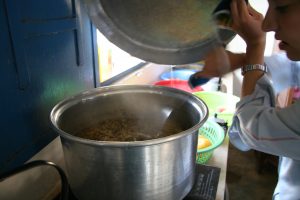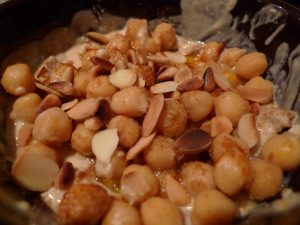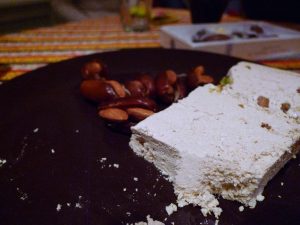I have strong connections to Syria, to its people, places, history, and culture. Before these dark and distressing days of its civil war, I spent much time working in the northern parts of the country near Hasseke, Raqqa, and Aleppo. I found much mystery and romance preserved in its cities and ancient ruins, and a lot to love in its steppes full of fat-tailed sheep and mountainous region overflowing with sunflowers, pistachios, and cows.
In Syria, history runs deeps. Its two largest cities, Damascus and Aleppo, are among the oldest, continually-occupied cities in the world. Aleppo’s most visible monument, its citadel, has occupation within dating back to the mid-3rd millennium BC, though it is more famous for its resistance to Crusader incursions in the 12th century AD, and for damage and occasional vanquishment by centuries of Mongol invaders. Far more ancient is evidence for one of the world’s earliest cities and fantastic (and macabre!) remains of early warfare, both at an archaeological site that I work at, Tell Brak, and also sites further east such as Tell Hamoukar. We know about thriving 3rd and 2nd millennium diplomacy, economy, and culture from large archives of clay tablets from Mari, Ebla, and Ugarit. Descriptions of rituals are also recorded, but we learn far more about them from finds of animal breeding, sacrifice, and burial from sites such as Umm el-Marra, at which I also work. From “classical” history, the Syrian desert houses important Hellenic- and Roman- era cities of Dura-Europus and Palmyra, whose 3rd century regent-Queen Zenobia rebelled against Rome (read about her world here). Ancient Bosra, also in the desert, was the capital of Rome’s Arabian province and home to one of the largest theatres ever built. Until the civil war, the theatre was still used for cultural events and festivals. Early Christianity flourished in Syria, particularly in Antioch (now the Turkish Hatay) and Afamea (Apamea). Those of you close to Baltimore can see stunning mosaics excavated from Antioch at the Baltimore Museum of Art.
Modern Syria is no less intriguing than its ancient past, and among its many treasures is phenomenal food. In the suq (bazaar), spice stalls overflow with za’atar and Aleppo pepper, and olives, figs and pistachios fresh from the tree. I don’t think I’ve ever tasted better cherries than those I spend much of the month of June eating by the handful. Street foods abound, with shawarma and fuwaki (fruit juice) stands on every other corner. Like other places, Syrian cuisine varies regionally – even a basic shawarma sandwich. I am most familiar with Aleppo cuisine, which is justly considered among the best in the Middle East. I love it all, from its particular collection of meze, including muhammara and creme thum, to its kibbeh variations, nutty freekeh, and stunning array of lamb kebabs featuring mint, pistachio (called “fistik halabiya” or Aleppo nuts), and cherries. Armenians have added their flavors to the cuisine, particularly in the Jdeidah quarter, where I have spent many, many wonderful evenings.
My “knowledge” of Damascus cookery is much more limited. Damascus is the capital, and its cosmopolitan streets house many cuisines including French, Indian, Japanese, and Chinese. For local cuisine, I more frequently eat lunch in the Old City at restaurants serving traditional platters of shawarma, or evening spots near Bab Touma offering pizza, meze, arak, and beer or at a wine bar named Vino Rosso that also served Italian meats and cheeses.
Yet, archaeology tends to throw together into one spot people from a multitude of places and traditions, who may not otherwise interact. When that happens we share fairly nuanced details of our disparate lives and cultures. This is especially true when meals are cooked. Excavations typically have cooks, but there are times when the archaeologists do the cooking for special occasions, or for relief of stress or boredom. These are often lengthy, complex affairs featuring local ingredients – as those are easiest to come by, and the vegetable markets in Syria are full of some of the freshest, juiciest, tastiest tomatoes and cucumbers I have ever had. Since local ingredients are most knowledgeably used by locals, it is through such meals that I came to know a bit of Damascene cuisine, usually from long-held family recipes. Some of my favorites?
Mujaddara is certainly one. This stew of rice, lentils, and carmelized onions is simple, comforting, and delicious. This was made for our group by a Syrian archaeologist named Lujain, who claimed she couldn’t cook, but whose finished product proved otherwise. There are many recipes for it, but this one was posted on my birthday! Stuffed grapes leaves are another favorite, and I definitely prefer the most savory style – sans currants or raisins. I learned a wonderful technique for cooking them, which is to line the bottom of a pot with thick onion slices, placing the stuffed leaves on the onions for cooking; the onions taste wonderful! For dessert I adore the crisp sesame/pistachio cookies, Barazeek, that can be found in many Damascus bakeries.
But, one of my absolute favorite dishes is Molukhia. Molukhia is prepared throughout the Middle East, with variations across the region. The main ingredient is a nutty green (Molukhia) that is commonly called “Jew’s Mallow” in English. While I have not tried other preparation styles, I love the drier, whole-leaf, Damascus version that I have had in Syria and, now, at home in Philly.
How did I come to have this fantastic dish in Philly? I was treated to a home-made meal of regional Damascene cooking by my Syrian friend and fellow archaeologist, Salam, who is spending the year in Philadelphia. Four archaeologists – Salam, Lauren, Marie-Claude, and myself, were joined by engineer Evan for a meal of Molukhia – but also Fatteh, Tabouleh, sweets, and wine – and great company, of course! Since none of the rest of us knew how to make any of the meal, Salam slaved over the stove alone – well, we did chat and offer drink refills.
Our first dish was Tabouleh, a pretty common salad that is served with many meals. It is made with chopped parsley, other herbs and vegetables, and a bit of bulghur – dressed with lemon. I prefer it this way, with less bulghur, as lighter and more refreshing. It is visible in the picture to the left with the lettuce leaves – a good accompaniment and easy way to eat the Tabouleh.
Next was Fatteh. Fatteh is made across Syria from the main ingredients chickpeas, yoghurt, and bread. This dish is served in all the cafes that line the suq and face the citadel in Aleppo, but my favorite is served at Shamiyaat, a small, busy, lunch spot in Damascus, just up the street from the National Museum. The Damascus version is much lighter on the oil/fat, and that is the type that Salam made for us. Hers was a little different, too, for keeping many of the chick peas whole – instead of pureeing/mashing the majority. This, and the almonds on top, made it crunchier – with great texture – and gave it a pretty color.
The star of the show, in my opinion, was the Molukhia: vibrant, nutty greens cooked with garlic, lemon, and chicken. It is reminiscent of a similar dish cooked with spinach, but the extra nuttiness of molukhia greens impart a deeper, more complex flavor. This is a dish that excites a lot of opinion, in part because, like okra, the greens can become fairly slimy when cooked. Okra is featured in another Syrian dish that I like, bamiya, made with okra, tomato, and lamb. In both the Bamiya and the Molukhia, Syrian recipes call for the addition of tomato to help keep the greens from getting slimy. Interestingly, this technique is also used when cooking okra in the American South. Salam’s family recipe (at bottom) calls for a whole, uncut tomato to be cooked in the dish. The resulting Molukhia was not at all slimy, and is further distinguished from other recipes – particularly Egyptian – by less broth/juice.
By this point – if you know me – you may be wondering about the wine… Yes, what about the wine? Well, we started with a convivial, easy drinking Rioja contributed by Lauren. It was perfect for the slight chill of the evening and went great with conversation.
For the meal, I had thought long and hard about a great pairing for the Molukhia. I decided on Rkatsiteli, Chateau Mukhrani, Republic of Georgia. Rkatsiteli is a grape that is indigenous to Georgia, but that I had long ago fallen in love with in wine produced by Dr. Konstantin Frank in the Finger Lakes of New York. I felt the wine had a lighter texture to pair well with the greens and garlic, as well as an aromatic nose to mingle with all of those foods. The acid and citrus in the wine would be a good match for the dish, as a whole, and definitely for the Fatteh. The pairing definitely worked. The apple fruits were joined by some lighter tropical flavors in a slightly creamy body, but the whole wine was just so vibrant that it interacted with the greens and garlic and chicken perfectly. I will seek out other Chateau Mukhrani wines, and will certainly purchase this one again. I also love the fact that this wine is from the Republic of Georgia – probably around where the earliest vinifera grapes were domesticated – and possibly the birth of wine production.
This was also a great choice for near eastern archaeologists – especially as we all have ties to the Museum of Archaeology and Anthropology at the University of Pennsylvania, where quite a bit of work on early wine-production has been done.
We ended our meal with a final course of traditional Syrian halwa and almond-stuffed dates. Halwa is a somewhat dry and crumbly paste made with sweetened tahini, often with the addition of pistachios. Mmmm. What are you making next, Salam?
Molukhia
Ingredients:
- 400 gram of green molukiah or 200 gram dried, soaked 1 hour
- 300-500 gram diced chicken breast
- 1 cube vegetable or chicken stock
- 1 large tomato
- 2 tsp coriander seeds
- 1 tsp black paper
- 4 bay leaves
- 4 cloves of cardamom (optional)
- 2 medium size dried red chilies
- 1 medium size onion (optional)
- 8 cloves of garlic
- Large bunch of green coriander
- 5 or more tbsp of vegetable oil
- 2 lemon, 1 to cook, 1 to serve
Cooking:
Bring 1-1.5 liter of water to boil, add spices, stock, bay leaves and chicken. Cook for 20 minutes.
Wash, rinse and squeeze the molukhia leaves well to reduce slimness. Heat oil in a large pan and stir-fry the until leaves’ sprigs are a little brown (don’t over fry).
Add the chicken mixture and the boiled water to the pan, and add 4 crushed cloves of garlic. Peel the tomato and add it whole. Add the whole onion, optionally cooked.
Cook for 30 minutes on low heat,.
Stir-fry the chilies, chopped coriander, and remaining crushed garlic and add to the pan. Squeeze in one lemon and cook for another 15 minutes on low heat. That’s it!
Optionally remove the tomato and onion, or crush/chop into dish.
Serve with rice
A traditional side is a mixture of broken toasted flat bread, a mix of vinegar and small diced raw onion.












[…] exactly what I wanted: Chateau Mukhrani Rkatsiteli. I have written about this Georgian wine before, when I paired it with a Syrian meal. I was certain that its floral aromatics, vibrant citrus, […]